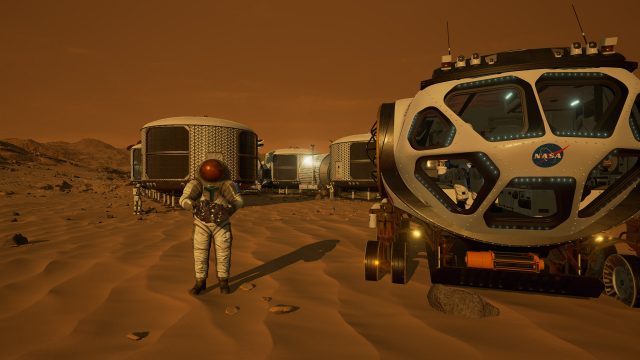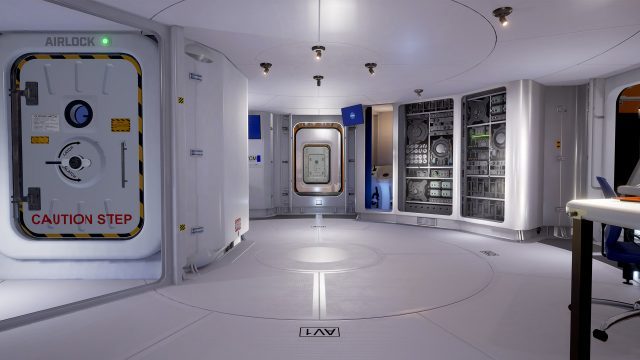The education-focused Mars 2030 launches today on SteamVR for the HTC Vive and Oculus Rift, soon to come to PSVR. With 40 square kilometers of explorable terrain, the experience successfully achieves its main objective: to make the user feel like they are on Mars. However, while its stunning canvas has great potential, its execution currently suffers from a lack of features, and a number of technical problems.
Update (8/8/17): After initially providing Road to VR with what was said to be a launch build of Mars 2030, developer FMG Labs decided at the last minute to postpone the launch of the game. The release build, now available on Steam, addressed many of the issues I identified in my earlier hands-on with the pre-launch build. This update offers an overview of the experience based on the launch build, while our impressions from the pre-launch hands-on remain below.
While Mars 2030’s overall presentation remains a mixed bag, the newer build has resulted in a much more playable experience. Most notably, the menu system is now largely functional, the camera reset feature is clearer, and ‘comfort mode’ has effective snap turning. Starting from the opening menu, the game now states immediately how to recenter the camera. The app now remembers graphics settings, and the save slots appear to be reliable.
The deployment sequence has been polished, with my virtual hands no longer clipping through my knees. Once landed, the tutorial now reliably appears, with useful HUD elements showing controller inputs. The ‘teleport’ feature is still always available (not necessarily a bad thing, but perhaps it should be an option), but the comfort mode is now fully functional, making the teleports instantaneous rather than a quick dash, and the right stick (or right touchpad on Vive) performs 45 degree snap turns.
Strangely, vehicle travel seems even more redundant in the current build. Not only can you teleport around so much faster than the SEV can move, but you can also ‘fast travel’ to every site instantly. In the preview build, I had to physically reach a site on foot (or hit autopilot in the SEV, where it would drive in real-time), and place the flag to unlock the ‘fast travel’ function for that site. There was a small sense of achievement in reaching each location in this way, which has been lost now that you can simply fast travel everywhere from the beginning.
Many information points marked with floating ‘i’ icons are now active (they were totally absent from the preview build), providing some written details about the equipment and how it might be used for the Mars project in the future. The Habitat in particular is full of information points, which certainly adds to the educational value. The software now remembers my ‘geolab progress’, and the microscope analysis is more stable, but remains fairly unintuitive with motion controls.
The app continues to feel more suited to gamepad input, but motion control isn’t as awkward as it once was. The super-sensitive tilt inputs for the vehicle have now been significantly toned down. And thanks to the camera reset buttons, it is now practical to enjoy the opening sequence and vehicle sequences while seated, and then stand while exploring on foot or walking around the labs. However, this can result in some odd animation problems, with the virtual body sometimes looking like it is crouched in mid-air, or with the legs not reaching the ground.
The experience no longer feels quite so ‘unfinished’, but it remains rough around the edges. For instance, I’ve loaded my save to find myself ‘stuck’ underneath the SEV, rocks I pick up will occasionally fall through the surface, and the software seems to suffer from some pretty serious performance issues, possibly relating to fast travel. Each time I appeared in a new location, the framerate seemed to drop further (reloading the save would restore performance). Hopefully FMG Labs continues to optimise Mars 2030 with future updates.
Update (7/27/17, 9:28AM PT): A spokesperson for FMG Labs says the launch of the experience has seen a slight delay. There’s no indication on the new launch date yet, however the game’s Steam page currently indicates availability beginning tomorrow, July 28th. The original article below has been updated to reflect this new information.
Original Article (7/27/17): Unquestionably, Mars 2030’s greatest assets are… its assets. The vast landscape is covered in detailed geometry and textures, and the habitat, vehicles, and other equipment are modelled to a high quality. Combined with convincing lighting and shaders, the result is, at times, very impressive.
The Mawrth Vallis region has been reproduced using satellite data from NASA’s Mars Reconnaissance Orbiter HiRISE, with topographical data accurate to within 30cm of the actual elevation. As described in our first experience of Mars 2030 at GTC 2016, the team went to great lengths to represent the martian terrain in the most realistic manner, using Unreal Engine 4’s physically-based rendering. “Our lead environment artist actually worked with a NASA geologist to find the correct reflectance factors to really get the materials to be as photorealistic as possible,” said Justin Sonnekalb, a designer on the project.
Available soon via SteamVR for the HTC Vive and Oculus Rift, the Mars 2030 journey begins on the final descent towards the planet. I’m told to push the giant ‘detach’ button, which is where the first body Presence problems become apparent.
The inverse kinematics on the avatar’s arms look odd, probably because the hands (and their resting position) don’t seem to line up agreeably with where my hands fit on the Vive controllers. My character is seated, so I feel compelled to sit too. Resting the controllers on my knees, the virtual hands clip through my virtual legs. It’s possible to reset the camera and sit in such a way that this doesn’t happen, but it would certainly benefit from some fine tuning here. (After being spoiled by the incredible hand animation in Lone Echo, this kind of thing stands out.) While this could be explained as the result of maintaining 1:1 tracking of the hands, the hands also clip through the legs if you play it with a gamepad, where you have no direct control of your arms—something that doesn’t occur in the rover, so I suspect it can be fixed.
After the landing sequence, I appear ‘outside’, with my avatar now standing. The problem is, if I then physically stand, I end up floating above the surface. So I start hunting for a camera reset button, and unfortunately, the Vive controller map (and indeed every controller map) is blank. I eventually figured out that the camera reset is pressing the left trigger and right ‘grip’ button simultaneously, but I still haven’t discovered the shortcut for gamepad. A tutorial sequence is then supposed to activate, but over multiple restarts of the software, it only seemed to trigger 50% of the time.

I’m instructed to move around, use the scanner, and pick up a few rocks. Here, the physics system seems to struggle, and it’s not just from the weaker gravity. Tasked with placing flags at notable locations, these act as a checkpoint and can then be used for fast travel. Several times, the flags ended up flying out of my hand rather than elegantly fitting into place, and the problem seemed even more prevalent when using a gamepad.

After this, you jump into the rover, and my character is sitting again. I grab the virtual joystick with my left hand. Unfortunately, when operated by the tilt of the Vive controller, the movement is unnecessarily sensitive, causing the vehicle to move erratically due to its 6-axis system. Using a gamepad or keyboard in this case is far more intuitive and stable. Thankfully, there is an autopilot feature, which means you can enjoy the view instead of wrestling with the controls. Then, whenever you exit the vehicle, you’re given a brief ‘pressurisation’ animation of your character climbing into their suit. It’s jarring, as it feels like an out-of-body experience, particularly as every other transition is a simple fade to black.
Much like Steve Wozniak’s demo, I also experienced dizziness, as the vehicle movement is unusual (the unfamiliar martian gravity is probably a factor too) and the on-foot locomotion is smooth, including rotation—a common cause of nausea. The opening tutorial suggests there is now a ‘comfort mode’, but exactly what that entails is unclear, as enabling or disabling the function had no obvious effect.

However, there is a permanent ‘teleport’ function that appears active whether you want it or not, so perhaps this is a bug. What it desperately needs (for those sensitive to smooth locomotion in VR) is a snap turning option, which is presumably what the comfort mode is supposed to enable. The teleport feels rather overpowered, as it allows the user to fly across the landscape at breakneck speed, much faster than the rover can travel. As a result, the temptation is there to mash the button and ‘cheat’ your way across the terrain rather than enjoying the journey.








